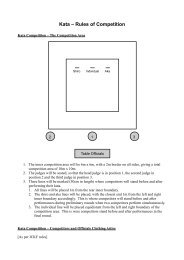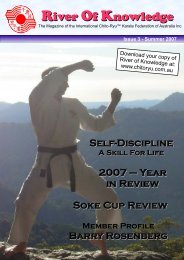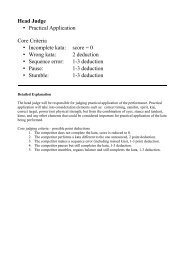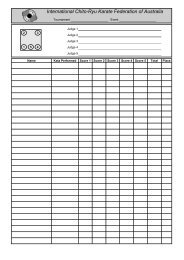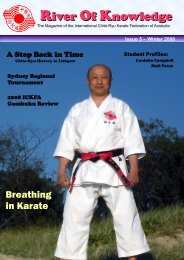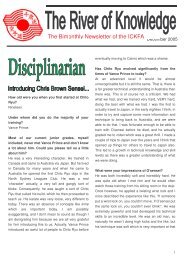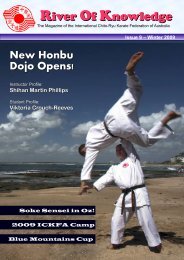Issue 4 - March 2008 - International Chito-Ryu Karate-do Federation ...
Issue 4 - March 2008 - International Chito-Ryu Karate-do Federation ...
Issue 4 - March 2008 - International Chito-Ryu Karate-do Federation ...
You also want an ePaper? Increase the reach of your titles
YUMPU automatically turns print PDFs into web optimized ePapers that Google loves.
Written by Martin Phillips Sensei and Helen O'Grady<br />
Breathing and<br />
Cardio-Vascular<br />
Fitness<br />
Part 1<br />
Introduction by Martin Phillips<br />
When we first start learning <strong>Karate</strong>, specific fitness<br />
training is not really a high priority, instead<br />
improved fitness is a natural result of proper<br />
training. One of the fundamental elements of the<br />
physical aspects of <strong>Karate</strong> is correct breathing.<br />
Much like swimming controlling the timing and<br />
volume of ones breath is essential in quality<br />
training and also a vital element of cardiovascular<br />
fitness.<br />
If we breathe in at the wrong time we are potential<br />
leaving ourselves in a vulnerable position to be<br />
attacked. If we breathe out at the wrong time the<br />
power of our attacks is considerably decreased. By<br />
focussing on our breathing when we practice our<br />
basics and kata, we naturally develop the correct<br />
timing and control of the volume of our breath. The<br />
following article explores how breathing relates to<br />
general cardiovascular fitness.<br />
Article By Helen O'Grady (Personal Trainer)<br />
There are three main indicators used to measure<br />
physical fitness, they are cardio-vascular fitness,<br />
muscular strength and endurance and flexibility. In<br />
order to effectively have a lasting improvement in<br />
overall physical fitness all of these aspects need to<br />
be addressed and trained, but perhaps the most<br />
important aspect and the one that has the most<br />
impact on the effectiveness of all other training is<br />
cardio-vascular fitness.<br />
Cardiovascular fitness can be defined in simple<br />
terms as the efficiency with which our body (heart<br />
lungs and circulatory system) provides oxygen to<br />
our muscles and how effectively we use that<br />
oxygen (O2) to produce energy during moderate to<br />
high intensity exercise.<br />
When looking at increasing cardio fitness there<br />
are two areas to consider. The first is mechanical<br />
efficiency. This is the ability of the physical body to<br />
<strong>do</strong> what is required of it. In this case, the ability of<br />
the heart and lungs to absorb O2 from the air, and<br />
pump oxygenated blood around the body to the<br />
muscles. When we regularly increase our heart<br />
rate, our heart, like any other muscle, becomes<br />
stronger and increases the amount of blood it can<br />
pump with each beat (stroke volume). An increase<br />
in stroke volume enables us to work at a higher<br />
intensity while maintaining the same heart rate.<br />
This second aspect is perhaps the most important.<br />
This is the physiological adaptation. It is not just<br />
how much oxygen we breathe that is important but<br />
rather how well we can use that oxygen.<br />
When we begin to exercise, we very quickly use<br />
up the available energy that is stored in our<br />
muscles. When this happens the level of Carbon<br />
dioxide (CO2) in our blood is raised and this<br />
triggers the brain to increase the rate of breathing<br />
to provide more O2 for energy to the muscles.<br />
This balance between CO2 and O2 in the blood<br />
is very important as CO2 is used by the body to<br />
release O2 from the blood and into the muscles. If<br />
we <strong>do</strong> not properly control our breathing or<br />
exercise at too high intensity, there is a tendency<br />
for respiration to increase too much which upsets<br />
the O2/ CO2 balance so our body can no longer<br />
efficiently utilize the O2 for energy. As we breathe<br />
in more and more oxygen and breathe out CO2<br />
our blood becomes very oxygen rich but there is<br />
not enough CO2 to release this O2 into the<br />
muscles to be burned for energy.<br />
River of Knowledge – Autumn <strong>2008</strong> 22



